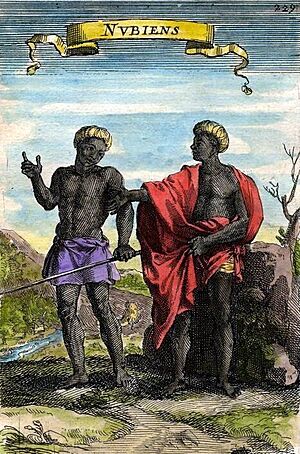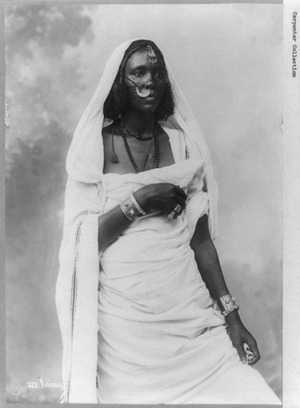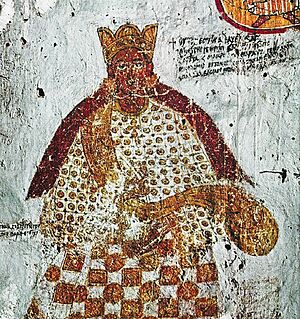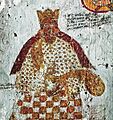Nubians facts for kids
| Nobī النوبيون |
|
|---|---|

Modern Nubian men in Aswan
|
|
| Regions with significant populations | |
| 167,831 (1956 census) 812,000 | |
| 99,000 (1960s) 300,000–5,000,000 |
|
| Languages | |
| Nubian languages Arabic (Sudanese Arabic, Sa'idi Arabic, Egyptian Arabic) |
|
| Religion | |
| Sunni Islam | |
| Related ethnic groups | |
| Sudanese Arabs, Beja, Egyptians, Cushites, Nilotic peoples | |
The Nubians are an ethnic group who have lived for a very long time in the area that is now northern Sudan and southern Egypt. They are believed to be some of the first people to live in the central Nile valley, which is considered one of the earliest places where civilization began.
In southern Egypt, Nubians have their own unique culture and traditions, different from other Egyptians. They often speak Nubian languages as their first language and Arabic as a second language.
Archaeologists have found very old settlements in Nubia, dating back about 9,000 years. The area of Wadi Halfa is thought to be one of the oldest settlements in the central Nile valley. Parts of Nubia, especially Lower Nubia, were sometimes part of ancient Egypt and sometimes powerful kingdoms like Meroë or the Kingdom of Kush.
Around 744 BC, the Nubian pharaohs of the 25th Dynasty ruled all of Egypt, extending their power far south. Ancient Nubians were famous warriors, especially skilled with the bow and arrow. Later, during the Middle Ages, many Nubians became Christians and formed three kingdoms: Nobatia, Makuria, and Alodia. Over time, they gradually converted to Islam.
Today, many Nubians in Egypt live in southern Egypt, near Aswan, and in big cities like Cairo. Sudanese Nubians live in northern Sudan, along the Nile. Some Nubians had to move from their homes when the Aswan High Dam was built in Egypt, which flooded their old lands.
The main Nubian groups along the Nile are the Kenzi, Faddicca, Halfawi, Sukkot, Mahas, and Danagla.
Contents
What Does "Nubian" Mean?
Throughout history, different parts of Nubia had different names. Some names meant "Land of the Bow" or "Land of Gold."
The exact origin of the names Nubia and Nubian is still debated. Some experts think "Nubia" comes from an ancient Egyptian word for "gold" (nbw). However, ancient Egyptians usually called people from this area nḥsj.w. The Roman Empire later used the term "Nubia" to describe the region in southern Egypt and northern Sudan.
A Look at Nubian History
Nubia's history goes back about 300,000 years! Around 6000 BC, people in the region started farming. Over time, they even used a writing system similar to Egyptian hieroglyphs.
Important periods in ancient Nubian history include:
- Early Cultures: Like the A-Group (3700–2800 BC) and C-Group (2300–1600 BC).
- Kerma Culture: A powerful kingdom (2500–1500 BC).
- New Kingdom of Egypt: When Egypt ruled parts of Nubia (1550–1069 BC).
- Twenty-fifth Dynasty: Nubian kings ruled Egypt (1000–653 BC).
- Napata and Meroë: Important Nubian kingdoms (1000 BC–350 AD).
- Christian Kingdoms: Nobatia, Makuria, and Alodia (340–1504 AD).
Archaeological finds show that people lived in Nubia very early on, possibly even before many parts of the Egyptian Nile Valley. Some scholars believe that the ancient Egyptian civilization was influenced by early farming communities in both Egypt and Sudan.
Even though Egypt and Nubia share a long history, their paths separated after Alexander the Great conquered Egypt in 332 BC. The area between the first and sixth cataracts of the Nile then became known as Nubia.
Egypt was later conquered by the Persians, Greeks, and Romans. During the Roman period, the Kushites formed the kingdom of Meroë, ruled by powerful queens called Candaces. It's said that a Candace of Meroë even scared off Alexander the Great! Historically, Nubians defeated the Roman Emperor Augustus Caesar, leading to a good peace treaty for Meroë. The kingdom of Meroë also defeated the Persians.
Later, Christian Nubian kingdoms successfully fought off invading Arab armies three times. This led to the Baqt, a peace treaty that lasted for 600 years – one of the longest in history! The Christian kingdoms of Nubia eventually fell in the early 1500s, leading to the spread of Islam and later, rule by the Ottoman Empire and the British. After Sudan became independent from Egypt in 1956, the Nubian people were divided between southern Egypt and northern Sudan.
Modern Nubians speak Nubian languages, which are part of the Nilo-Saharan family. The Old Nubian language is one of the oldest recorded languages in Africa outside of the Afroasiatic family, dating back to the 8th century AD.
Nubia had different regions with varied farming and landscapes. The Nile river valley in the north and center allowed farming with irrigation. Other areas had a mix of farming and nomadic life. Nubia was also important for trade, especially for gold and exotic goods from other parts of Africa, which passed through to Egypt.
Nubian Languages
Modern Nubians speak Nubian languages. These languages belong to the Eastern Sudanic branch of the Nilo-Saharan family.
However, experts are still figuring out what languages were spoken in Nubia a very long time ago. Some evidence suggests that different language families, like Cushitic languages and Eastern Sudanic languages, were spoken in different parts of ancient Nubia.
For example, some researchers believe that the people of the Kerma culture spoke Nilo-Saharan languages. Other groups in Lower Nubia might have spoken Afro-Asiatic languages, like Cushitic.
The ancient Meroitic language is another mystery. Some scholars think it's related to the Afroasiatic family, while others believe it's part of the Nilo-Saharan family, like modern Nubian languages.
Nubian Greeks
The Axumite Empire from Ethiopia invaded Nubia in the 4th century AD, which led to the end of the independent Nubian Pagan kingdoms. The Axumites tried to bring their type of Christianity to Nubia. However, Egyptian-based Christianity became more popular, leading to the creation of new Nubian Christian kingdoms like Nobatia, Alodia, and Makuria.
Some nomadic groups, like the Beja, managed to stay independent. Eventually, some of these nomads adopted Greek culture and joined the Nubian Greek society that was already present in Lower Nubia.
Nubian Greek Culture
Nubian Greek culture was similar to Egyptian Greek and Byzantine Greek civilization. This was seen in their art and writings. The Nubian Greek language was used for trade and communication across the Nubian Kingdoms. It even borrowed words from Coptic Egyptian and Old Nubian.
Nubian Greek art, especially frescoes (wall paintings) from 800–1200 AD, showed religious life in the Nubian Kingdoms. These paintings were made in the Byzantine art style.
Nubian Greek titles and government styles were based on Byzantine models. Even when Islamic influence grew, the Nubian Greeks still looked to Constantinople as their spiritual home. Nubian Greek culture slowly disappeared after the Muslim conquest of Nubia around 1450 AD.
Nubians Today
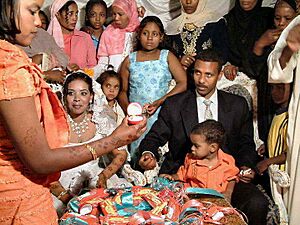
The descendants of the ancient Nubians still live in the area that was once ancient Nubia, mainly in modern Egypt and Sudan. Many Nubians had to move from their homes in the 1960s when the Aswan High Dam was built, flooding their ancestral lands.
Today, many Nubians work in cities in Egypt and Sudan. While Arabic was once mainly learned by Nubian men who traveled for work, more Nubian women are now learning it through school, radio, and television. More Nubian women are also working outside the home.
During the Yom Kippur War in 1973, Egypt used Nubian people as code talkers. They spoke in their Nubian language to send secret messages, which was very helpful because the enemy couldn't understand them.
Nubian Culture
Nubians have a strong shared identity, which they celebrate through poetry, stories, music, and novels.
Modern Nubians in Sudan include groups like the Danagla and Mahas. These Nubians sometimes use their own writing system. Some older Nubians also practice scarification, where they have small scars on their cheeks or temples. However, younger generations are less likely to continue this tradition.
Nubia's culture was shaped by its geography. It's often divided into Upper Nubia (where the ancient Kingdom of Napata was) and Lower Nubia. Lower Nubia was a "corridor to Africa," where Nubians interacted with Egyptians, Greeks, Romans, and Arabs, leading to a rich cultural exchange.
Ancient Egyptian rulers wanted control of Nubia's wealth, especially gold, and its important trade routes. This led to Egypt ruling Nubia during the New Kingdom period. Later, the Nubian Kingdom of Meroe became very powerful and even ruled Egypt for about a century. Nubian kings were known as wise leaders who supported art and learning. They even copied ancient Egyptian texts and brought back some Egyptian traditions.
After this, Egypt's influence on Nubia lessened. Meroe became the main center of power, and Nubia's cultural connections with other parts of Africa grew stronger.
Religion
Today, most Nubians practice Islam. Their religious practices often mix Islam with some older folk beliefs. In ancient times, Nubians practiced a mix of traditional religions and Egyptian religion. Before Islam spread, many Nubians were Christian.
Islam arrived in Nubia starting in the 8th century. While Christians and Muslims often lived peacefully, Arab armies sometimes invaded Christian Nubian kingdoms. For example, in 651, an Arab army invaded Makuria but was pushed back. A treaty called the Baqt was signed, which prevented more invasions in exchange for a yearly payment. This treaty also required Nubians to keep a mosque for Muslim visitors.
Over time, Nubians slowly converted to Islam, starting with the leaders. Sufi preachers, who are Muslim mystics, helped spread Islam in Nubia from the late 14th century onwards. By the 16th century, most Nubians were Muslim.
Ancient Napata was an important religious center in Nubia. It was home to Gebel Barkal, a large sandstone hill that looked like a rearing cobra to ancient people. Egyptian priests believed it was the home of the ancient god Amun. Both Egyptians and Nubians worshipped their gods in Nubia for 2,500 years. Nubian kings and queens were buried in pyramids near Gebel Barkal, just like the Egyptian pharaohs. Nubian pyramids can be found at Gebel Barkal, Nuri, El Kerru, and Meroe.
Nubian Architecture
Modern Nubian homes in Sudan have a special look. They often have a large courtyard surrounded by a high wall. A big, beautifully decorated gate, usually facing the Nile, is a key feature. Brightly colored plaster is often used, decorated with symbols related to the family or popular designs like geometric patterns, palm trees, or the "evil eye" symbol, which is believed to ward off bad luck.
Nubians also invented the Nubian vault, which is a special curved roof structure.
Notable Nubians
- Luqman: An ancient wise man known in Islamic tradition.
- Alara of Kush: The founder of the Twenty-fifth Dynasty of Egypt.
- Taharqa: A powerful Pharaoh of the Twenty-fifth Dynasty.
- Amanitore: A famous Queen (Kandake) of the Kingdom of Kush in Meroë.
- Silko: A 6th-century king who helped bring Christianity to Nubia.
- Qalidurut: A 7th-century king who defeated Arab Muslim invasions and signed the long-lasting Baqt treaty.
- Moses Georgios of Makuria: A 12th-century king of several Nubian kingdoms.
- Jaafar an-Nimeiry: A former Sudanese president.
- Mohamed Mounir: A famous Egyptian Nubian singer, known as "The King."
- Mohammed Wardi: A well-known Sudanese Nubian singer.
- Mo Ibrahim: A Sudanese-British businessman and billionaire.
- Hamza El Din: A singer and musicologist.
- Mohamed Hussein Tantawi Soliman: An Egyptian Field Marshal and statesman.
- Muhammad Ahmad: A 19th-century Sufi leader and revolutionary.
Images for kids
See also
- Barabra is an old term for the Nubian peoples of Sudan and southern Egypt.
- Nubian wig worn by wealthy people in ancient Egypt.
- Aethiopia is an ancient Greek term for regions in Sudan and south of the Sahara desert.




